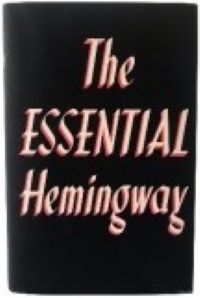
How essential was The Essential Hemingway?
To answer the above question, we have to start with the Portable Hemingway, published by the Viking Press in 1944, edited, and with an introduction and brief prefaces, by literary critic Malcolm Cowley; it was the sixth title in the popular and expanding series eventually known as the Viking Portable Library. It was also the first full anthology of Hemingway’s work and, with the inclusion of Cowley’s editorial matter, it constituted an important marker in the changing perception of Hemingway from popular author to an artist deserving serious critical attention.
When the contract for material licensed from Scribner’s expired after five years, Scribner’s cancelled the contract and the Portable Hemingway, in spite of selling more than 45,000 copies, was rendered out of print by 1950 (Cowley 317-18).
The book did enjoy a sort of afterlife, however, in the form of The Essential Hemingway, published in the U.K. by Jonathan Cape. It appeared in October 1947 (Hanneman 85), stripped of Cowley’s introductory material but otherwise keeping the same table of contents, in the order of Cowley’s original plan.
Bibliographer C. Edgar Grissom notes that, in fact, the Portable and the Essential “possess identical content presented in identical order, other than the absence of Malcolm Cowley’s editorial material in the English printing.” He therefore treats them “jointly as printings of the same collected material with the [Essential Hemingway] treated as a revised edition of the American VPL” (Grissom 259). This edition was, at about 5¼ x 7¾ inches, slightly larger than the Portable and, with the absence of Cowley’s introductory material and prefaces, made a 448-page book (versus the Portable’s 672 pages). The Essential Hemingway was, in effect, simply the U.K edition of the Portable Hemingway.
Unlike the Portable, the Essential had a long life. Grissom references nine hardcover printings through 1961, an Oxford Reader’s Union edition (1947), a Companion Book Club edition (1962), a Penguin paperback in 1964 (which was reprinted through 1974), a Panther paperback in 1977, and a Random House U.K. paperback in 1993 (under the Arrow imprint), followed by their Vintage paperback in 2004 (Grissom 262-66). These various versions were sold in the U.K., Australia, New Zealand, South Africa, and Canada—but not in the U.S.
I was curious about this book—how did it come to be published, and how did it continue to flourish in multiple editions, while the more-popular Portable virtually disappeared?
Works Cited
Cowley, Malcolm. “A Letter From Malcolm Cowley.” Fitzgerald/Hemingway Annual 1971. Edited by Matthew J. Bruccoli. Microcard Editions, 1971, pp. 317-18. Letter dated 13 Oct. 1970.
Grissom, C. Edgar. Ernest Hemingway: A Descriptive Bibliography. Oak Knoll Press, 2011.
Hanneman, Audre. Ernest Hemingway: A Comprehensive Bibliography. Princeton U P, 1967.
Hemingway, Ernest. Ernest Hemingway: Selected Letters 1917–1961. Edited by Carlos Baker. Scribner’s, 1981.
Howard, Michael S. Jonathan Cape, Publisher: Herbert Jonathan Cape, G. Wren Howard. Cape, 1971.
Scribner, Charles Jr. In the Company of Writers: A Life in Publishing. Scribner’s, 1990.
Peter Coveney was formerly Executive Editor for History at Wiley, managing the overall History team and acquiring text and reference titles in European, British, and World History. He has also held positions at Oxford University Press, Harper & Row, and CBS College Publishing. He is a contributing editor for Firsts Magazine, where he has published more than two dozen articles on various aspects of book culture, publishing history, and book collecting. He presented at the Hemingway Society Conference in Paris in 2018.